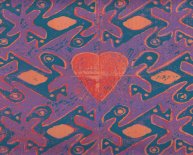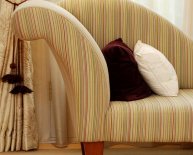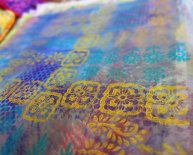
Printed Textiles Artist
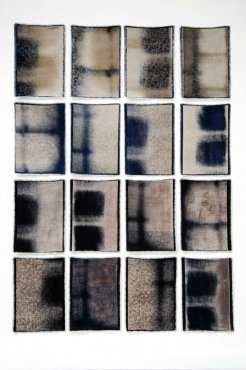
The layering process
Textile Artist: What initially captured your imagination about textile art?
Joanna Kinnersly-Taylor: I’ve always loved the essential qualities and purity of cloth, the idea of transforming its surface and being able to work on a large scale. When I discovered screen-printing, everything fitted into place. The layering process that this method allows perfectly suits my thought processes, and for me is the best way of making ideas tangible and communicating the way I experience the world.
What or who were your early influences and how has your life/upbringing influenced your work?
This is both important and unimportant. The encouragement and nurturing one receives through childhood ineveitably plays a part in instilling a level of confidence in following a path, and my grandmother was an important person, but in the end, it all comes from deep within, regardless of ones background. The only way I am able to process how life unravels, is through my work and without this I would feel very lost.
What was your route to becoming an artist?
I received a BA (Hons) in Printed Textiles from (formerly) West Surrey College of Art and Design in Farnham (now University College of the Creative Arts). The course was very technical and provided a firm foundation, which has proved extremely valuable over the years. I subsequently completed a Master of Design post-graduate degree at Glasgow School of Art.
What is your chosen medium and what are your textile art techniques?
Working on natural fibres such as linen and wool, I combine screen-printing, stencilling and painting. I will also often dye the cloth first, and that forms my first layer; even if it is just a pale colour, I prefer this to working straight onto a white background. The different types of work that I do inform how much or little I work into the surface. For example, a tea towel is often only a one-colour print – a flat, more graphic style, whereas my gallery or commissioned pieces will often be much more layered. I am always amazed at how much a flat surface can be ‘carved out’ through the push and pull of removing and adding colour, creating positive and negative space.
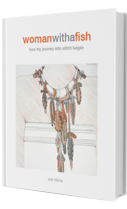
Textile artists who cross boundaries
How would you describe your work and where do you think it fits within the sphere of contemporary art?
My work covers three distinct areas and so I describe myself as a ‘textile artist and designer’, as I feel this best defines the scope of my practice. Although there are no fixed boundaries, I subconsciously adopt different mindsets, depending on the type of project I am working on. If I am carrying out a public commission, then both these roles are important. Whereas, when I create one-off works for exhibition, I adopt a much more fine art approach. By contrast, my domestic linens are evolved whilst wearing my designer’s hat. The chosen audience and environment therefore exist fairly naturally. I enjoy all the different outcomes that result from working in this way.
Because of the crossovers that exist within my practice, I would define myself as akin to those printed textile artists who also cross boundaries. It is probably the nature of textile printing and its inherent need for space and equipment (ie. It is not something easily done in the spare bedroom), that requires quite a broad approach in order to remain financially secure. There has been a burgeoning of textile artists who see that adaptability enables survival, and I think that providing one’s creative integrity is retained, this can be a very positive thing, enhancing and stretching one’s skills.
I sense that printed textile art techniques are sometimes underestimated in terms of labour and process. The action of transferring imagery to cloth via a screen takes a matter of seconds that belies all the hard work done at the preliminary stages. Because by nature, screen-printing is a repeatable process, the perception can be that it is ‘easy’ and therefore of less intrinsic value than, say, a woven textile, where the labour is more ‘visible’ even if one has little or no knowledge of the process involved. This can result in one-off printed textile pieces being misunderstood and being seen as neither serious artwork nor finely crafted object.
The ‘magpie’ stage
Tell us a bit about your process and what environment you like to work in?
This is made up of many stages, partly because that is the way I evolve things, but it also reflects the time-consuming nature of the printing process. Initially I go through a ‘magpie’ stage, a gathering process of a seemingly disparate range of encounters: a passage from a book, a photograph, a particular colour, pattern or object, drawings, scribbled random notes and observations. This can be enlightening, as parallels and links are made, creating a feeling of resonance that occurs when one is fully ‘tuned-in’. Filtering and refining then follows, providing the focus required to realise the essence of the idea and this is often the hardest part. Even though many elements may not be utilised, they have probably entered into the subconscious, and may have subtle influence, permeating obliquely into the work. I will often record this process in written form – the physicality of writing is important to me – it might be quite diagrammatic. This rationalisation might sound rather formal when it actually happens quite naturally, but ongoing analysis helps me retain sharpness of thought.
Ideas are worked through in a sketchbook phase before experimenting with scale and composition using Photoshop.
The separate layers here are so useful for screen-printers. Artwork is then printed, screens coated with a light-sensitive emulsion and then exposed to ultra-violet light. There follows an intense sampling stage, both to check colours and also to find the best printing order – whether one layer works better underneath or on top of another, if and when the print should be steamed before the next layer goes on etc. It is only through this part of the process that I am able to get a real sense of how to approach the print. When it starts to take on a life of its own, it can be unsettling at first – you have to get to know your work as if for the first time – but in the end it is your job to gently steer it in the right direction, without forcing it.
Everything I do is recorded, as once I am happy with a sample, I need to know how to repeat it with minimum strife! This methodical approach and attention to detail then allows me the freedom to be spontaneous and that is the joy of screen-printing. A successful print will ultimately only come about because the hard work has been done at an earlier stage.
I have moved studio several times over the years, but I am fortunate now to have a large and warm space within an artists’ studio complex in Glasgow. Here I have gradually built up all the equipment I need to be self-sufficient, which is a good feeling. In the longer-term though, I dream of a less urban environment – a studio at the bottom of the garden, where I can be more in touch with nature.

